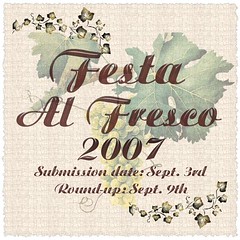Alte Kochbücher kommen immer wieder zu Ehren; so auch Spanisch kochen in Deutschland aus der Meine Familie und ich Kochbuchserie der 1980er Jahre.
1 Schweinefilet (600g)
3 Eßl. Olivenöl
1 Zwiebel
4 große Knoblauchzehen
3 Fleischtomaten, gehäutet und entkernt
Salz, Pfeffer
125 g in Scheiben geschnittene grüne Oliven
1 Glas Weißwein
1 Gläschen Sherry Fino
1 Bund Petersilie
Zubereitung:
Schweinefilet in Medaillons schneiden, Fett und Sehnen entfernen. In einer Pfanne in Olivenöl goldbraun braten. Zwiebeln, Tomaten und Knoblauch in kleine Würfelchen hacken. Fleisch aus der Pfanne nehmen und im Backofen zwischen zwei Speisetellern warm halten. Mit Salz und Pfeffer würzen.
In die Pfanne sofort Zwiebeln und Knoblauch geben, anrösten, Tomaten zufügen. Solange rösten, bis der Bratenfond gelöst und fast alle Flüssigkeit verdampft ist. Die Olivenscheiben mit Wein und Sherry zugeben und die Sauce abschmecken. Den aus den Medaillons gelaufenen Bratensaft und die gehackte Petersilie unterrühren. Medaillons einlegen und auf milder Hitze noch 10 Minuten ziehen lassen.
Guten Appetit!! Pork filet slices a la Sevilliana
Pork filet slices a la Sevilliana
Old cookbook are in the shelves, so with me a serie of My Family and I German Cookbooks on European Cuisine, this about Spanish Cooking in Germany.
Ingredients:
1 pork filet
3 sp olive oil
1 onion
3 garlic cloves
3 tomatoes peeled and seedless
salt, pepper
125 g green olives in slices
1 glas white wine
1 tiny glas sherry fino
1 bunch parsley
Preparation:
Cut the filet into slices, get rid of fat, skin ect. Roast it till golden in olive oil, salt and pepper and let rest under plates in the oven.
Roast onion and garlic, add tomatoe and roast to get rid of all extra fluid. Add wine, sherry and olives. Simmer again. Add meatjuice. Reduce heat, give filet slice into the sauce and let rest for another 10 minutes.
Enjoy!!
2007/08/09
Schweinemedaillons Sevilla Art * Lomo de cerdo a la sevilliana
2007/04/25
Estragondip * Tarragon Dip
 Der wuchernde Estragon macht erfinderisch.
Der wuchernde Estragon macht erfinderisch.
Dip
Zutaten:
einige Stengel Estragon
einige Blätter Sauerampfer
einige Zweige Olivenkraut
2-4 kleine vorgekochte Kartoffeln
Joghurt
Olivenöl,
Weißweinessig
Zubereitung:
Estragonblätter, Sauerampfer etwas Olivenöl, Essig, Joghurt und Kartoffeln in einen Cutter geben und mischen bis eine cremige Masse entsteht. Im Kühlschrank einige Stunden ziehen lassen.
Kann als Dip zu verschiedenen Gemüsen gereicht werden, passt gut zu frischem Spargel.
Guten Appetit! Tarragon Dip
Tarragon Dip
Neverending supply of tarragon makes me creative. This time its a dip with leftover potatoes.
Ingredients:
some sprouts of tarragon
some leaves of sorrel
some sprouts of olive herb
2-4 little potatoes
joghurt, olive oil
white wine vinegar
Preparation:
Give all into a cutter, adding little olive oil and vinegar, enough joghurt to smoothen the dip, mix thoroughly.
The dip may be used with different vegetables, but is a hit with asparagus!
enjoy!
2007/03/31
Ricotta-Gemüse-Charlotten * Ricotta-Vegetable Charlotta
Host of this weeks weekend herb blogging # 76 is Kalyn of Kalyn´s Kitchen in Utah, USA. She´s the foundress of this event.


Rezept inspiriert von: Picolle Charlotte die Ricotta e verdure in der Cucina Italiana 3/2007 S. 30
Leider ist das Rezept fehlerhaft, so dass es nicht gelingen kann, wenn es nicht abgewandelt wird.
Zutaten:
12 Scheiben Toastbrot, sie geben nur 6 Scheiben an. Wie sollen daraus 4 Kästchen werden?
500-700 g Gemüse: verwendet wurden:
2 Möhren besser: 4 Möhren
1 Zuchini 2 Zuchini
1 Avocado
2 Paprika 4 Paprika
8 Tomaten
5oo g Ricotta
1 Ei
Rapsöl zum anbraten
Pfeffer, Salz
1 Knoblauchzehe zerdrückt
Zubereitung:
Die Toastbrotscheiben platt rollen, pro Portion eine als Boden ganz belassen, die beiden anderen halbieren. Einen Backrahmen mit ihnen auslegen.
Gemüse getrennt in dünne Scheiben schneiden, in Öl andünsten, salzen und pfeffern.
Ricotta mit dem Ei und Knoblauch zu einer glatten Masse verarbeiten.
In die Kästchen abwechselnd Gemüse und Ricottamischung geben, mit Gemüse beginnen, mit Ricotta enden.
Alles im Ofen bei 170° 20-30 Minuten backen. Lauwarm zu einem Riesling oder Weißburgunder servieren.
Wohl bekomm´s!!
Das Rezept ist ideal zur Resteverwertung.

Recipe inspired by Picolle Charlotte die Ricotta e verdure in der Cucina Italiana 3/2007 p. 30
The recipe had to be modified, because it didn´t
Ingedients:
12 slices of toast bread not toasted they recommended only 6 slices
500-700 g vegetables they said 200 g
I used:
2 carots better take 4 of them
1 gourgette 2 of them
2 red peppers
1 avocado
8 tomatoes
Preparation:
Take 3 slices of toast bread p.p., one for the bottom, four halves for the sides, roll them flat and put them in an bottomsless baking tin or some other tin 7x7 cm, 3cm high,
cut the veggies into thin slices, separtely roast them at low heat in an pan, add pepper and salt to taste,
mix ricotta and egg with garlic and maybe a bit of pepper, as you like.
put veggies and cream in layers into the bread frames, beginning with veggie ending with cream.
Bake in a preheated oven at 170°C for about 20-30 minutes, depending on your oven.
Serve warm or cold and enjoy!
you may drink a Riesling from Palatine or a Chardonnay with it.
You may use any veggie so it sounds to me a perfect dish to deal with veggies of an earlier dish.

Das Rapsöl zeichnet sich durch einen hohen Anteil an einfach ungesättigten Fettsäuren, insbesondere der Ölsäure, aus. In 100 Gramm Rapsöl sind 6 Gramm gesättigte Fettsäuren, 66 Gramm einfach ungesättigte Fettsäuren und 27 Gramm mehrfach ungesättigte Fettsäuren enthalten. Der Anteil der mehrfach ungesättigten Fettsäuren setzt sich u.a. aus 12 Gramm Omega-6-Fettsäure (Linolsäure) und 9 Gramm Omega-3-Fettsäure zusammen. Die gesundheitsfördernde Wirkung dieser Kombination macht es für viele Diäten interessant, es hat wenig Eigengeschmack, färbt gemüse oder Fleisch angenehm und kann sehr hoch erhitzt werden, der Rauchpunkt liegt bei 220°.
This weekend I´m not musing about herb or vegetable but of oil, rape seed oil, the blossoms of which are yellowing horizons in early summer.
Rape oil is known for it healthy combination of ingredients which even outstand those of olive oil. The mixture of multiple saturated fats omega 3 and 6 is best in this oil, so it is very healthy to heart and blood and recommended in a variety of diets. 100 g rape seed oil contain 6 g saturated fat, 66 g not saturated fat, 27 g multiple saturated fats, thereof 12 g Omega-6 fats and 9 g Omega 3 fats. Rape oil tastes indifferently, gives an agreeable colour to veggies and meat, and can be heated up to 220°C, because there´s actually its smoking point.
Eingestellt von
Helene
um
15:09
6
Kommentare
![]()
Labels: Backen, Baking, Oil, Öl, Weekend Herb Blogging






